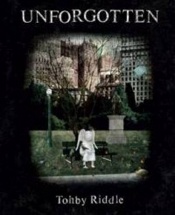Unforgotten by Tohby Riddle

Allen and Unwin, 2012. ISBN 9781742379722.
(Ages: 10+) Picture book. Memories. Caring for others. With the
plethora of novels written with angels as the main characters, it is
not surprising to see a picture book for older readers reprising
that theme. Many novels contain fallen angels, and in this one,
fallen is physical not a state of mind. Divided into three sections,
the bare bones of this picture book can be outlined as follows: the
first reveals what angels do for humanity, the second shows an angel
which has been overwhelmed by the work it must do, while the third
exposes a group of children and animals reviving the angel enough
for it to return home. All done in spare prose, the illustrations
entreat and seduce the reader to dwell, to admire, and to muse.
The angels oversee the human population in Europe, soaring overhead,
watching, being there, comforting, warming and mending. Their coverage
is enormous: there are wars to contend with, poverty, homelessness,
hunger, loneliness. But the angels keep on, until one day, one angel
can no longer go on. It falls to the ground, exhausted. And there it
stays, unnoticed and unloved, forgotten and alone. It is found by
workers who surround it with safety markers and then carry it away
to make a plinth for it to stand on.
With the plinth and the statue installed in a public place, it
lingers for years, unloved and dying, until a group of
children and animals take notice of it. They take it back to their
dwelling, and there nurse it back to health until, noticed and
loved, revived, it travels back to where it came from. The kindness
of strangers has overcome its forgotten state.
With acres of black space, the illustrations, made up of collage and
filled in pictorial work, draw the eye in to notice the detail. And
what detail! Photos from the turn of the century European cities are
juxtaposed with photos of New York, warehouses and lifts; pictures
of people in Victorian dress stand alongside those in more modern
clothing, or those of the 1930's; cars from the early part of the
twentieth century stream along the roads, bridges and buildings
highlighting the ever passing traffic, both of people and cars,
ignoring the angel. People have statue heads, bodies are part statue
and human, emphasising their indifference, watching as a statue
might, with unseeing eyes. Metaphor abounds in this richly layered
book, and will be looked at with awe by someone intrigued with the
symbolism of the illustrations. Not for everyone, this sumptuously
produced book will find a willing home amongst more discerning
middle school readers.
Fran Knight